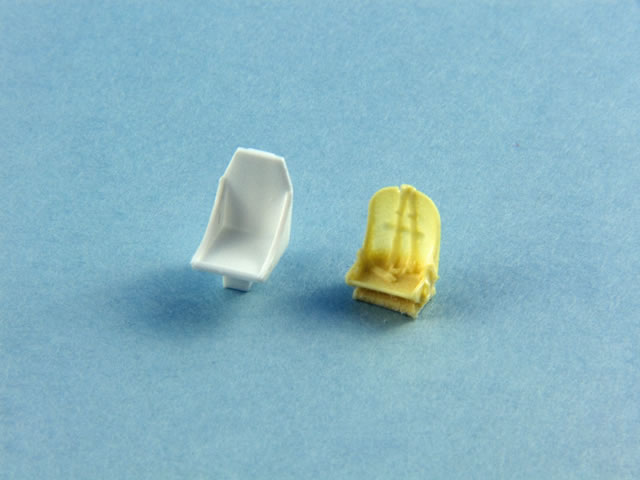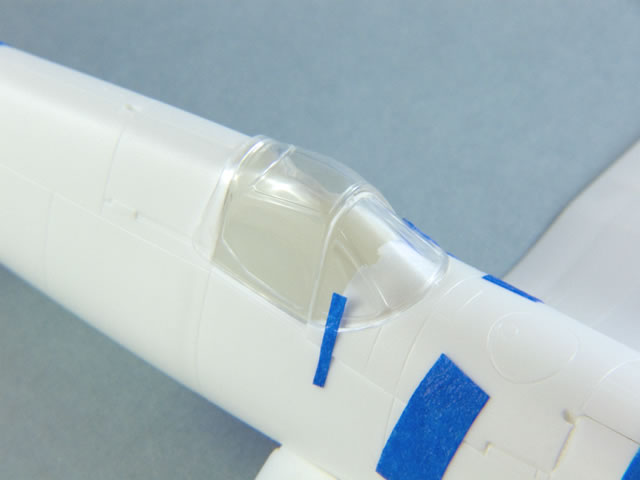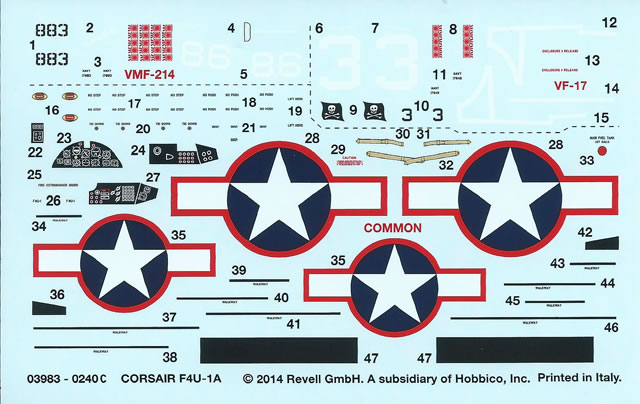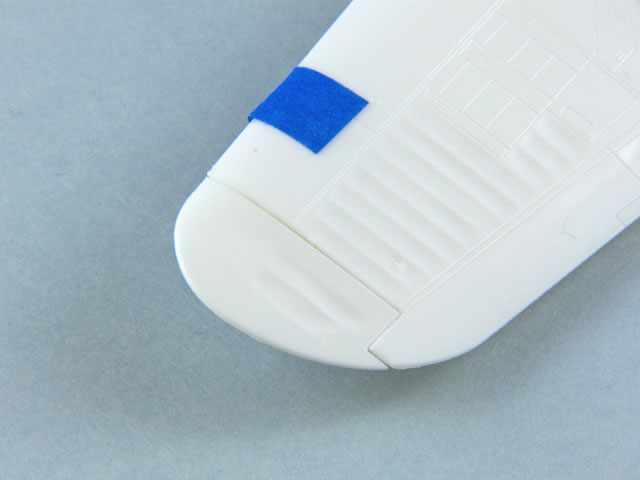|
F4U-1A Corsair

Revell Germany, 1/72 scale
S
u m m a r y |
| Catalogue Number: |
Revell Germany Kit No. 03983 - F4U-1A Corsair |
| Scale: |
1/72 |
| Contents and Media: |
All plastic injection molded kit including 61 parts in white styrene with recessed panel line and rivet detail and 2 clear. |
| Price: |
USD$16.14 plus shipping available online from Squadron.com
GBP£6.50 plus shipping available online from Hannants |
| Review Type: |
FirstLook |
| Advantages: |
Nice overall detailing, accurate depiction of floorless cockpit. |
| Disadvantages: |
Some detail parts poorly molded, some details incorrect for -1A variant, detail lacking in certain areas, minor errors on the decal sheet. |
| Conclusion: |
I am glad that companies like Revell-Germany and Airfix are releasing affordable kits to provide beginners with an entry point. Experienced modelers and Corsair fans will be able to handle the detail challenges posed by this kit without too much trouble. |
Reviewed by Rafe Morrissey

Revell's 1/72 scale F4U-1A Corsair is available online from Squadron.com
The F4U Corsair was one of the most significant American fighter designs of the Second World War. Though its early development was plagued with problems, its superior performance provided the United States Marines with a platform to wrest aerial superiority from the Japanese. Once certain design quirks were resolved to permit it to better operate from Carriers, it quickly proved its worth as both an interceptor and fighter bomber in the latter part of the war.
Despite its importance, the Corsair was, until recently, denied the level of attention given to other designs like the Bf-109 and P-51 by model manufacturers. Most of the kits up until the 90s were “ballpark” kits missing many of the key details. With the introduction of an excellent series of kits in 1:48, 1:72 and 1:32 scale by Tamiya over the past decade, Corsair fans have finally been treated to fully accurate, top-quality kits. It has all come at a price, however. Being a self-described Corsair fanatic, I am always glad to see a new kit of the Corsair. Revell-Germany has a good reputation for solid, affordable kits, so I was eager to see how they would approach a kit of my favorite airplane.
Hits and Misses
Inspecting the kit produced a variety of emotions. My first reaction was to appreciate the very affordable price of the kit. The Tamiya kits are very nice but even the 1:72 scale kit retails for nearly $30USD. Depending on where one looks, it is possible to acquire the Revell-Germany kit for just a bit more than a third of that price. Keeping my wallet happy is always a good start. I do wish Revell-Germany had not molded the kit in white plastic. It may seem like a nit but not only is it hard to photograph, but it is also difficult to see the detail and make accurate cuts.
Looking through the kit contents was a bit of an emotional roller-coaster. As I looked over the parts I was continually thrilled to see some details captured much better than most of the earlier efforts only to be disappointed at lapses in other areas. For example, the kit is the only one in 1:72 scale besides Tamiya to correctly depict the floorless cockpit design. While generally correct in the configuration, however, the kit misses some key details. An incorrect center instrument panel is included beneath the main panel. The forward bulkhead is only partially represented instead of spanning the entire width of the fuselage.
The seat, always the most visible cockpit element in this scale, is poorly represented having the wrong shape and lacking detail.

The rear bulkhead contains cutouts suitable for an earlier “Birdcage” -1 variant but not appropriate for the -1A. (Incidentally, these cutouts and cut lines inside the fuselage halves suggest that a separate “Birdcage” version could be in the works, but it would have been nice to have the correct bulkhead included.)
Perhaps the biggest issue is the fact that the kit represents a blend of details from the -1A it purports to depict and the later -1D variant. The canopy is nicely molded and reflects the semi-blown, framed design of the -1A.

The propeller, however, is the later 13’1” paddle blade design. While some of the Corsairs in VF-17 were retro-fitted with these propellers, most -1As were fitted with the larger 13’4” version.

In addition, the pylons and drop tanks provided in the kit are only applicable to the -1D and neither of the marking schemes in the kit would have utilized these items.
Finally, while the kit provides for both open and closed cowl flaps, the open version lacks the spacers to fill to openings between each of the flaps.

They can be added with bits of .005 plastic card easily enough.
Decal Challenges
Speaking of the decals, the markings are mostly well-rendered with good registration and color values.

On the other hand, there are some annoying errors. The front gear numbers for the famous “Lucybelle” propaganda mount of Maj. Gregory “Pappy” Boyington are wrong being 883 instead of 86. It is clear the designer confused his or her research as 883 was the side number for an F4U-1A that Boyington actually flew in combat.
Fits and Starts
With any new kit, a complete test fit is critical in order to identify and plan for any fit challenges. I removed all of the airframe parts and cleaned them up so I could tape them together. I should also emphasize here that you really do yourself a favor test fitting the canopy at this stage. I have been lazy in the past in not fitting the canopy only to find out after the model is painted and nearly complete that there are fit issues with this essential part. If filling or modification is needed, it is best to find out right at the beginning.

The test fit of the Corsair reveals some pluses and minuses. Overall, the outline of the kit looks consistent with my references and the fit is generally good. The fit of the canopy is quite good, so finishing separately and adding at the end looks like it will be a good option.
There are some troubling areas, though. The cowling does not appear to fit well at all and the design is overly complex and clunky compared to Tamiya’s one piece design.
Another potential challenge is the wing tips.

Revell provides separate parts for these presumably to allow for doing a British clipped wing variant later. The placement of the seam is a bit odd and will require some careful filling. Perfect Plastic Putty to the rescue!
So, how does the Revell-Germany Corsair measure up?
Well, the price is certainly right.
The cockpit detail, while not perfect, provides a much better platform than any other manufacturer except Tamiya.
The mish mash of -1, -1A and -1D details are probably only an issue for the most ardent Corsair fans and as long as one does a VF-17 aircraft, it is not necessary to source a replacement prop. It still would have been nice to have it provided, though.
I am glad that companies like Revell-Germany and Airfix are releasing affordable kits to provide beginners with an entry point. Experienced modelers and Corsair fans will be able to handle the detail challenges posed by this kit without too much trouble.
I look forward to completing mine as a Bunker Hill F4U-1D.
Review Text Copyright © 2014 by Rafe Morrissey
Page Created 17 October, 2014
Last updated
17 October, 2014
Back to HyperScale Main Page
Back to Reviews Page |
